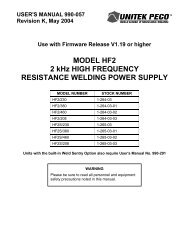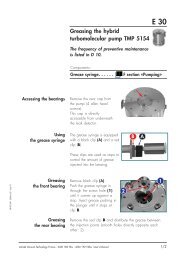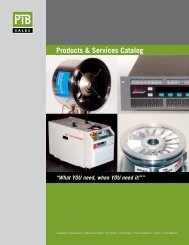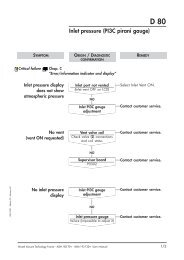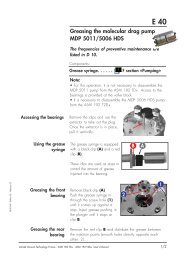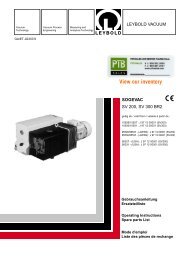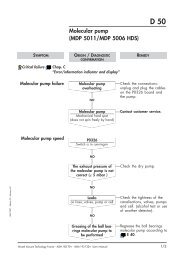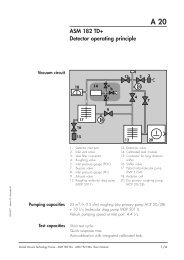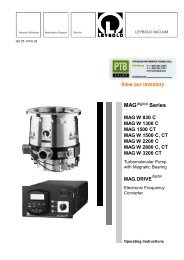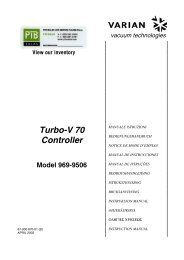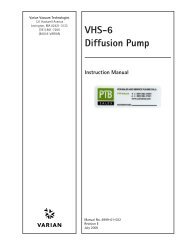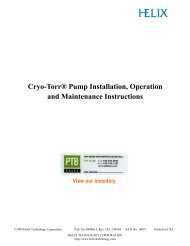CPS 1001/S/13.56MHz RF POWER SUPPLY - PTB Sales
CPS 1001/S/13.56MHz RF POWER SUPPLY - PTB Sales
CPS 1001/S/13.56MHz RF POWER SUPPLY - PTB Sales
You also want an ePaper? Increase the reach of your titles
YUMPU automatically turns print PDFs into web optimized ePapers that Google loves.
<strong>CPS</strong>-<strong>1001</strong>/S<strong>13.56MHz</strong><br />
FP0213RK<br />
<strong>CPS</strong> <strong>1001</strong>/S/<strong>13.56MHz</strong><br />
<strong>RF</strong> <strong>POWER</strong> <strong>SUPPLY</strong><br />
Operator’s Manual<br />
Copyright © 2004 by Comdel, Inc.<br />
The information contained in this manual is proprietary to Comdel, Inc. and is protected by copyright and trademark laws.<br />
You may not modify, copy, reproduce, republish, post, transmit, or distribute in any way any material from this manual except as may be<br />
expressly permitted in writing by Comdel, Inc.<br />
Comdel, Inc. • 11 Kondelin Road, Gloucester, MA 01930 • Phone: 800-468-3144 • www.comdel.com
Table of Contents<br />
I. Safety Information..................................................................2<br />
II. Description / Specifications....................................................5<br />
A. Electrical Specifications<br />
B. Protection Features<br />
C. Generator I/O Requirements<br />
D. Mechanical Specifications<br />
E. Environmental Specifications<br />
F. Testing Specifications<br />
G. Packaging and Shipping Specifications<br />
III. Unpacking and Inspection.....................................................9<br />
IV. Maintenance............................................................................9<br />
V. Preparation For Use...............................................................9<br />
A. Power Requirements<br />
B. Cooling Requirements<br />
C. Installation Procedures<br />
VI. Operating Instructions .........................................................10<br />
A. Local Operation<br />
B. Remote Operation<br />
C. Test Equipment List<br />
VII. Theory of Operation.............................................................11<br />
A. DC Power Supply<br />
B. Oscillator Control Board<br />
C. Driver<br />
D. PA1000 Power Amplifier<br />
E. Directional Coupler<br />
F. <strong>CPS</strong> Meter Board<br />
VIII. Adjustments and Calibration............................................13<br />
A. Over Voltage / Over Current Adjustment<br />
B. VSWR Adjustment<br />
C. Output Power and Forward Monitor Calibration<br />
D. Reflected Monitor Calibration<br />
IX. Figures<br />
FP0213RX<br />
FP0213RX.drg<br />
FA0105RX<br />
FA0207RX<br />
FA0401RX<br />
FA0603RX<br />
<strong>CPS</strong> <strong>1001</strong> / 13.56 MHz Block Diagram<br />
<strong>CPS</strong> <strong>1001</strong> Control Drawing<br />
13.56, 1 KW Standard Directional Coupler<br />
1 KW / 13.56 MHz “S” Driver<br />
Oscillator Control Bard 13.56 MHz Standard<br />
Integrated Meter Assembly, Standard<br />
1
NOTE: Before installing equipment, carefully read and familiarize yourself with the entire<br />
operations manual. Observe and obey all WARNING and CAUTION notes provided.<br />
I. Safety Information<br />
Warning Label and Safety Marking Explanations:<br />
The following symbols and terms may be found on an instrument or used in this manual.<br />
The CE mark indicates compliance with all currently applicable directives and standards.<br />
This label indicates a general warning or caution condition.<br />
This symbol indicates the presence of high voltages in or around the unit.<br />
This symbol indicates that the component or circuit is short circuit protected.<br />
This symbol indicates the presence of <strong>RF</strong> energy in or around the unit.<br />
This symbol indicates a protective earth ground connecting point.<br />
This label indicates a<br />
presence of high voltage in or<br />
around the equipment, which<br />
may cause sever injury or<br />
death. All appropriate<br />
precautions should be<br />
observed when installing,<br />
operating or servicing this<br />
equipment.<br />
This label indicates the presence<br />
of Radio Frequency energy in<br />
and around the equipment,<br />
which may cause burns or other<br />
injuries. All appropriate<br />
precautions should be followed<br />
when installing, operating or<br />
servicing this equipment.<br />
2
The WARNING heading used in this manual explains dangers that might result in personal injury or<br />
death. Always read the associated information very carefully before performing the indicated<br />
procedure.<br />
The CAUTION heading used in this manual explains hazards that could damage the unit. Such damage<br />
may invalidate the warranty.<br />
MUST – This word is understood to indicate a mandatory condition.<br />
HIGH VOLTAGE – Voltages greater than 50 volts DC or 25volts AC and known to cause death or<br />
serious injury if contacted.<br />
SERVICE – Any operation of maintenance, repair, calibration or similar activity other than the normal<br />
operation of the unit.<br />
QUALIFIED SERVICE TECHNICIAN, QUALIFIED ELECTRICIAN, QUALIFIED<br />
PERSONELL These terms indicate persons specifically trained to install, service or other wise handle<br />
electronic equipment of the character and hazard potential of this unit.<br />
End User Labeling<br />
The system installer should obtain and apply all appropriate safety and warning labels required by the<br />
end user’s local fire department jurisdiction and Occupational Health and Safety Administration over<br />
and above those supplied by the generator manufacturer.<br />
Read And Understand This Section Fully Before Installing or Operating This Equipment.<br />
WARNING: This equipment must be installed, operated and serviced only by trained, qualified<br />
persons.<br />
General Safety Requirements<br />
• WARNING: Hazardous Voltages and <strong>RF</strong> voltages are present inside this unit, which may cause<br />
injury or death. To prevent electrical shock and or <strong>RF</strong> burns, never operate this equipment with the<br />
covers removed. Never operate without an appropriate cable connected between the <strong>RF</strong> output<br />
connector on the rear panel and the load.<br />
• CAUTION: There are no user or operator serviceable parts inside this equipment. Refer all<br />
service to a qualified service technician.<br />
• This equipment must be bonded to Protective Earth (safety ground) prior to operating the unit.<br />
Safety ground connection must be made at the unit’s rear panel designated 1/4”- 20 threaded<br />
ground stud. The ground wire should be a #14 awg or equivalent (minimum) green/yellow lead.<br />
• Replace fuses only with identical type and rating parts. Installation and connection of this<br />
equipment must only be performed by a qualified electrician.<br />
• HEAVY OBJECT CAUTION: A heavy object caution exists for equipment weighing more that<br />
51 lbs or 23 kg. Use lifting aids to install unit, such as chain lifts or hooks and straps, attached to<br />
the four handles at the sides and front of unit. Guide unit into final location using care to keep<br />
hands and body parts clear of unit.<br />
3
CE Mark Specific Safety Requirements<br />
• This equipment meets all applicable safety directives (as specified in prEN50178) required to qualify<br />
for the application of the CE marking.<br />
• This equipment must be installed in accordance with the applicable requirements, or prEN50178<br />
and EN60204-1 / IEC-204-1.<br />
• This equipment is qualified to operate at Pollution Degree II and Insulation Category II.<br />
• The installation of this equipment must assure that the AC power input connector (UL/CSA) is not<br />
accessible to the user/operator. Access may be gained only by a qualified service technician. AC<br />
Mains connector installation must be in accordance with local requirements.<br />
• This unit provides appropriate separation between all interface, mains and output circuits in<br />
accordance with 5.2.18 of prEN50178.<br />
Interlock System<br />
• The low voltage (24 V) safety interlock circuit is designed to disable the unit in the event of an<br />
interlock fault condition. At a minimum, interlock protection is located at the removable top cover,<br />
bottom cover and <strong>RF</strong> output connector safety cover.<br />
• End user’s system should provide indication to the operator of the interlock fault condition.<br />
• Low voltage power for the interlock circuit is supplied by a step down transformer located inside<br />
the unit. This transformer is designed to provide safe low voltage operation and provide isolation<br />
from the main AC line.<br />
Lockout/Tagout<br />
Prior to performing system maintenance, repair or other service operations the generator must be locked<br />
out and tagged out to prevent accidentally energizing the system.<br />
The following steps should be performed only by a qualified service technician:<br />
• Disconnect AC input power to the generator.<br />
• Mount a suitable “Clamshell” type lockout device to the AC input plug such as a Hubbell # HLD2<br />
or equivalent. Follow all manufacturers’ directions for the lockout device.<br />
• Secure the lockout device with an appropriate padlock or safety lock.<br />
• Apply a lockout warning tag to the lock out device.<br />
The Lockout / Tagout device should not be removed until system service is completed and it has been<br />
determined appropriate to reconnect and operate the generator.<br />
4
II. Description / Specification<br />
The <strong>CPS</strong>-<strong>1001</strong>/S/13.56MHZ is a <strong>RF</strong> Generator operating with a center frequency of 13.56 MHz. The<br />
power source produces maximum transfer of power into a 50 ohm resistive load, yet it is designed to<br />
withstand large deviations in load impedance without failure.<br />
The primary features of the <strong>CPS</strong>-<strong>1001</strong> series are its solid-state design, small physical size and<br />
reliability.<br />
The <strong>CPS</strong>-<strong>1001</strong> series amplifier is constructed with two main sections. The DC power section includes<br />
all of the filter capacitors, rectifiers and regulators, as well as the three-phase 208 VAC power<br />
transformer. Transformers to accommodate other line voltages are available through special order. The<br />
rectifiers and bleeder resistors are mounted on a water-cooled copper heatsink. These components are<br />
operated at about half of their rated outputs to insure the high reliability of this section. The <strong>RF</strong> section<br />
consists of the oscillator control board (OCB), driver, PA 1000 power amplifier, combiner and<br />
directional coupler assembly. The driver and power amplifier modules are mounted on water-cooled<br />
heatsinks. All components are used well below their dissipation ratings for long life and low<br />
maintenance operation.<br />
The <strong>CPS</strong>-<strong>1001</strong> is enclosed in a standard 19” rack mounted chassis. The chassis is 5.25” high and<br />
16.125” deep (See the Control Drawing for further mechanical detail).<br />
NOTE: This product is subject to a “Copy Exact” agreement that requires written notification to the<br />
contract specialist prior to implementing any PART or PROCESS Changes.<br />
A. Electrical Specifications<br />
1. A/C Input Voltage: 180-229 VAC, 49-61Hz, three phase, NO NEUTRAL<br />
2. Line Current Protection: 10 Amp, 3 pole circuit breaker.<br />
3. Output Power: (within specified range of line voltage)<br />
3.1 0 to 1.0 KW continuous forward power into a 50 ohm load, 0 degrees nominal phase.<br />
3.2 0 to 1.0 KW continuous forward power into a plasma load of complex impedance<br />
with appropriate matching network.<br />
3.3 Forward power out to track command setpoint for reflected power less than 200 watts.<br />
4. Generator frequency: 13.56 MHz<br />
5. Frequency stability: +/- .005%<br />
6. Load Mismatch: Continuous operation into any load mismatch. Automatic forward power<br />
limiting above 200 watts reflected power.<br />
7. Harmonic distortion: All harmonics minimum 30 db below fundamental at full power<br />
8. Accuracy / Linearity / Regulation/ Stability:<br />
Setpoint Zero Offset: - 2% of full scale max<br />
Input to Output Linearity: +/- 3% of setpoint from 10-100%<br />
Input to Output Accuracy: +/- 3% of setpoint from 10-100%<br />
A/C Line Regulation: 2% max output change over rated voltage<br />
Forward Power Regulation: +/- 5% of setpoint max for load variations from 1:1 to<br />
5
1.5:1 VSWR within foldback limits<br />
Short Term stability: +/-1%/hr<br />
Long term stability: +/-5% over three years continuous output<br />
Zero Setpoint: less than 5 watts actual output power and less than 5 watts readback<br />
power when setpoint signal is at zero or at a negative voltage.<br />
NOTE: Use <strong>RF</strong> enable switch (Pins 4-9) 15 Pin D to ensure zero output power.<br />
B. Protection Features<br />
1. Mismatch Protection: Continuous operation into any impedance mismatch condition<br />
without damage or malfunction; forward power foldback shall occur within 500us if<br />
reflected power exceeds 150 Watts.<br />
2. Output power connection interlock: Hard-wired interlock that disables the input AC<br />
power contactor upon removal of the output cable.<br />
3. Safety interlock: Disables the input AC power contactor via the connector. MAX external<br />
loop resistance of 5.0 ohms .<br />
4. Over Temp Fault: Output disabled on high internal temperature<br />
5. Short Circuit Fault: Output limiting protection under short and open circuit conditions.<br />
6. Overdrive Limit: Internally limited at 1100 watts.<br />
7. Control signal protection: Unit not to be damaged if a short circuit or up to 30 volts AC or<br />
DC is placed between any input signal, return signal, and ground.<br />
C. Generator I/O Requirements<br />
1. Signal input impedance: 10K ohms, min.<br />
2. Signal input isolation: 1000 VAC MIN to the A/C supply line.<br />
3. Line connections: Linecord to be 14AWG 4 conductor (three phase & ground); linecord<br />
jacket material to be type "STO" gray; linecord to be crimped to NEMA L15-20P style<br />
plug; linecord length to be 4.5 ft. +/-6.0 inches as measured from the rear panel exterior to<br />
the strain relief end of plug. Reference MARINCO part number 2015P-AM1.<br />
MARINCO: One Digital Dr.<br />
Novato, CA 94949<br />
(415) 883-3347<br />
4. <strong>RF</strong> Output power Connector: One type "N" female coaxial connector<br />
5. Control connector: 15 pin subminiature "D" type, (female).<br />
6. Control signals and pinout:<br />
Pin 5: Power setpoint<br />
Pin 3: Forward power out<br />
Pin 2: Reflected power out<br />
0 to +10 VDC = 0 to 1.0 KW linear<br />
0 to +10 VDC = 0 to 1.0 KW linear<br />
0 to +10 VDC = 0 to 1.0 KW linear<br />
6
Pin 4: Power enable<br />
Enables the output oscillator with an external contact<br />
closure between pins 4 and 9 (24 VOLTS, 0.5 AMPS<br />
MAX SWITCHING)<br />
Pin 9: Power enable Common for Pin 4<br />
Pin 11: Safety interlock<br />
Enables the input A/C power contactor with an external<br />
contact closure to Pin 12. (24 VOLTS, 0.5 AMPS MAX<br />
SWITCHING).<br />
Pin 12: Safety interlock common.<br />
Pin 6: Signal common<br />
Pin 7: Power on indicator<br />
+5 VDC source when <strong>RF</strong> Power is on<br />
Pin 8: Power on common Common for Pin 7<br />
D. Mechanical Specifications<br />
1. Size: 17" W x 5.25" H x 16.125" D max.<br />
2. Mounting: Standard 19" rack.<br />
3. Cooling: 1.5 G.P.M. MIN, 35 degrees C MAX 25% glycol mix MAX<br />
4. Water connections: 1/4 NPT female, inlet and outlet.<br />
5. Front panel indicators:<br />
5.1 Power meters: Dual meters to indicate forward and reverse power.<br />
5.2 Power on indicators: Visible green LED to indicate A/C power on.<br />
5.3 Fault indication: Visible red LED to indicate temp fault.<br />
6. Handles: Two handles (left and right) to be mounted on the front panel exterior, evenly<br />
spaced on center, dimensioned<br />
7. Color: Front panel to be black with contrasting white alpha/numeric designators.<br />
8. Warning Labels:<br />
8.1 Safety Labels for hazardous voltages, Heavy Object, and Caution for lifting by<br />
water fittings are to be provided on operator visible areas of the generator. IEC<br />
standard symbols in user visible areas for start, stop, enable and cautionary<br />
conditions, PE ground, high temperatures and <strong>RF</strong> energy present.<br />
8.2 Special marking available at customers specifications<br />
E. Environmental Specifications<br />
1. Operating Temperature & Humidity<br />
1.1 Operating ambient temperature/humidity/air pressure: 10 to 40° C, 5 - 85%<br />
humidity (non-condensing, no formation of ice), 86-106 kPa. Class 3k3 per<br />
prEN50178.<br />
7
1.2 Inlet Water Cooling Requirements: 1.5 GPM @ 690 kPa (100 psi) max, 35° C<br />
Max.<br />
1.3 Coolant type: Water<br />
2. Storage and Transportation<br />
2.1 Storage temperature/humidity/air pressure: -25 to +70° C (class 1k4 per<br />
prEN50178), 5 - 95% humidity (non-condensing, no formation of ice, class 1k3),<br />
70-106 kPa (class 1k4).<br />
2.2 Transport temperature/humidity/air pressure: -25 to +70° C, 5 - 95% humidity,<br />
70-106 kPa (class 2k3).<br />
3. This equipment has been designed to be compliant with FCC Part 18 emission standards<br />
for EMI/<strong>RF</strong>I radiation. Radiated emissions shall also not exceed maximum levels<br />
permitted by ANSI C95.1-1982 standards on safety levels with respect to human exposure<br />
to <strong>RF</strong> and electromagnetic fields from 300KHz to 100GHz.<br />
F. Testing Specifications<br />
1. Production Acceptance Test: Each unit will be required to "pass" production acceptance<br />
testing and a "Final Test Report" will be generated to document results.<br />
1.1 Production Acceptance Testing process shall include as a minimum: Complete<br />
Parametric/Functional Tests covering: line regulation, calibration, linearity, burnin,<br />
over-temp test, open circuit test, MAX power test, harmonic distortion, AC<br />
ripple, and remote interface tests. Data sheet for each generator to be shipped<br />
with unit.<br />
G. Packaging & Shipping Specifications<br />
1. Accessories Supplied<br />
1.1 Final test results<br />
1.2 Operating manual<br />
2. Shipping<br />
NOTE: If there is a conflict between this document and customer Purchase Order<br />
then the latter supersedes.<br />
NOTE FOR REPAIRS: Unless repairs have accessories included with them and<br />
have them listed on the Return Material Authorization (RMA) Tag, returned materials<br />
will not have to fulfill procedural requirements for accessories.<br />
8
III. Unpacking and Inspection<br />
1. Carefully unpack the unit and inspect for any obvious signs of physical damage that might<br />
have occurred during shipment. Notify the shipping agent of any damage immediately.<br />
2. Check the outside of the unit for missing or loose mounting screws or broken parts.<br />
3. If there is shipping damage or the unit fails to operate properly upon receipt, report<br />
damage to the carrier and Comdel immediately.<br />
CAUTION: Breaking the seal or removing the warranty decal from this unit will void the<br />
warranty. If internal damage is suspected, contact factory for assistance.<br />
IV. Maintenance<br />
The <strong>CPS</strong>-<strong>1001</strong> is designed to run unattended for long periods of time. Should service be<br />
required, the system is modularly designed for quick repair. The whole <strong>RF</strong> section could be<br />
replaced in less than thirty minutes.<br />
After a time, scale may build up on the inside of the cooling tubes. This could greatly reduce<br />
the cooling capacity of the system. It is recommended that the system be flushed with a<br />
descaling agent. A cleaning agent that does not damage copper, brass, stainless steel and nylon<br />
tubing should be chosen.<br />
V. Preparation for Use<br />
A. Power Requirements<br />
The <strong>CPS</strong>-<strong>1001</strong> is designed to operate from a 208 VAC three phase line. The system will<br />
function within specifications when line voltage fluctuates between 185 and 230 volts.<br />
However, voltages over the recommended 208 VAC reduce the safety margins designed into<br />
the system and should be avoided. Lower voltages impact power output and regulation. The<br />
system draws a maximum of 8 amps per phase (at 208Vac line) when used to drive a load of 50<br />
ohms. Under conditions of mismatch, the amplifier could draw slightly more current.<br />
Nominal Input:<br />
208 VAC, 3 Phase<br />
50/60 Hz<br />
8 Amps<br />
This system utilizes 3 wire plus ground (no neutral) wiring.<br />
B. Cooling Requirements<br />
The <strong>CPS</strong> <strong>1001</strong> requires 6 liters/minute (1.5 gallons per minute) to cool sufficiently. The inlet<br />
water pressure should not exceed 60PSI. Water temperature should not exceed 35° C, and<br />
should not fall below a temperature where excess condensation could develop within the unit.<br />
The ambient air temperature of the generator should not exceed 35° C. There should be<br />
enough room over the top of the amplifier and along the sides to permit unobstructed airflow<br />
through and around the unit.<br />
9
C. Installation Procedures<br />
1. This equipment must be installed in accordance with the directives of PREN50178 and<br />
EN60208-1 / IEC-208-1.<br />
2. This equipment is qualified to operate at pollution degree II and installation category II.<br />
3. This equipment is intended to be powered from a 208VAC, 3 Phase source. For use at<br />
other voltages, a safety isolation transformer must be used to power this equipment in<br />
accordance with the directives of EN60742 / IEC-742.<br />
4. The installation of this equipment must assure that the AC power connector (UL/CSA) is<br />
not accessible to the user/operator. Access may be gained only by a qualified service<br />
technician.<br />
5. Customer supplied AC mains connector installation to be in accordance with local<br />
requirements<br />
CAUTION: There are no user serviceable parts inside this equipment. Refer all service to a qualified<br />
service technician.<br />
VI. Operating Instructions<br />
Operating and monitoring the <strong>CPS</strong>-<strong>1001</strong> generator is accomplished either locally at the front panel or<br />
remotely. A front panel toggle switch selects either local or remote control. The remote monitoring and<br />
control interface is handled through the rear panel mounted 15-pin female “D” type connector, called J1.<br />
A. Local Operation<br />
1. Install 50 ohm coaxial load to output terminal of generator. Attach interlock sleeve on<br />
output cable to capture output cable interlock. The generator is normally supplied with<br />
Type N coaxial connectors. RG-8/u cable is sufficient to carry the output power from<br />
generator to load. Load should have at least 1500W dissipation rating.<br />
2. Pin 11 or rear panel connector J1 must be grounded to enable the main power contactor<br />
(Pin 12 is ground). Pin 4 of rear panel connector J1 must be connected to Pin 9 (<strong>RF</strong><br />
enable).<br />
3. With the front panel circuit breaker in the “OFF” position, attach the primary supply line<br />
to the appropriate supply mains.<br />
NOTE: Units are shipped wired for 208V, 3 phase, 50/60 Hz unless specified by<br />
customer.<br />
4. Place local/remote switch in “LOCAL” position.<br />
5. Rotate power control knob fully counter-clockwise.<br />
6. Check that cooling water is on.<br />
7. Check to confirm that all cover and cable interlocks are satisfied.<br />
8. Turn on the front panel circuit power breaker.<br />
9. Turn power control knob clockwise until full power is indicated on front panel power<br />
meter. (Reflected power will not indicate.)<br />
10
B. Remote Control Operation<br />
1. To control power remotely, a positive DC voltage must be applied to Pin 5 of J1 (Pin 6 is<br />
the return.) Control voltage of 0 to 10V yields an output of 0 to 1000 watts. Voltages put<br />
on this pin exceeding 10 volts will produce higher power up to a point. However, warranty<br />
of the unit cannot be maintained if the unit exceeds its design rating of 1000 watts.<br />
2. Forward and reflected power can be monitored remotely through Pins 3 and 2 respectively<br />
(Pin 6 is the return). Forward power is related linearly to 0 to 5 VDC corresponding to 0<br />
to 1000 watts. Reflected power relates 0 to 5 VDC linearly to 0 to 1000 watts. (Optional<br />
0 to 10 VDC may be chosen for full scale power monitoring.)<br />
C. Test Equipment List<br />
Instrument Type<br />
and Cables<br />
Min. Req. Spec<br />
Recommended Instruments<br />
and Accessories<br />
50 ohm Coaxial Resistor 1500W dissipation Bird Electronics Thermaline<br />
coaxial Resistor #8860<br />
Water Chiller 25-30 degrees C.<br />
1.5 GPM min<br />
Neslab Cool Flow<br />
Refrigerator Recirculator<br />
Model CFT-33XW<br />
VII. Theory of Operation<br />
The <strong>CPS</strong>-<strong>1001</strong>/S/13.56MHZ is a high frequency <strong>RF</strong> generator. The power source consists of three DC<br />
Power Supplies, oscillator control board, driver, power amplifier, directional coupler and integrated meter<br />
assembly. Schematic diagram dwg# FP0213RI is a compete system drawing down to the module level.<br />
A. DC Power Supply (schem dwg# FP0213RI)<br />
The DC supply consists of a three-phase transformer, a three phase full-wave, bridge rectifier,<br />
and low-pass filter for the high current DC power supply. This supply is used primarily by the<br />
driver and power amplifier (PA). There are two regulated low current power supplies. Both<br />
are on the integrated meter assembly printed circuit board (+/- 15VDC). The +/- 15VDC<br />
supplies are used in the oscillator control board (OCB) and on the integrated meter board.<br />
The outputs of this stage are:<br />
1 50 VDC max. Unloaded<br />
41 VDC Loaded (1000 watts <strong>RF</strong> output)<br />
1 +15 VDC Regulated 250 mA max.<br />
1 -15 VDC Regulated 150 mA max.<br />
B. Oscillator Control Board (schem dwg# FA0401RE)<br />
The oscillator is a hermetically sealed crystal circuit clock oscillator with a frequency stability<br />
of .01%. The signal from the oscillator is buffered and amplified by two stages of gain. This<br />
signal is now fed into the OCB output stage. The output is a class “C” amplifier stage. Output<br />
power of this stage varies from 0 to 1.0 watts by changing VCC. The VCC is changed via the<br />
ALC (automatic level control) circuit. There are no trimming or adjustments required in the<br />
<strong>RF</strong> part of the circuit due to its broadband and low “Q” matching networks.<br />
The automatic level control (ALC) circuitry smoothes output power control and stabilizes<br />
output power against line and load variations. Control is achieved through the MC34082<br />
11
operational amplifier, U5A. This op-amp compares the forward power signal (from the<br />
directional coupler board) to that of the DC reference signal applied to the non-inverting input.<br />
The reference level is set either from the front panel potentiometer or from Pin 5 of the J1<br />
connector.<br />
When the reference is applied to the U5A, it drives the gain control transistor Q4, until the<br />
squared forward power signal from the directional coupler is equal to the inverting input to the<br />
op-amp provided by the reference. When the inverting signal equals the reference voltage on<br />
the non-inverting input, the drive level holds constant.<br />
The non-inverting input is the connection point for the protection circuits. The OCMA pulls<br />
this point down when the load conditions force the amplifiers near their over-voltage, or overcurrent<br />
limits. This limits the drive to the amplifiers until the match between the generator and<br />
the load is corrected.<br />
The reflected power limiter performs in the same way. When the signal from the reflected<br />
power detector in the directional coupler reaches a pre-set limit, the U5B amplifier pulls -down<br />
the reference line until the VSWR conditions are within safe limits.<br />
The oscillator control board also includes linearizing circuitry, allowing both forward and<br />
reflected analog power level signals to appear at connector J1 as linear representations of the<br />
forward and reflected <strong>RF</strong> output power. Two squaring ICs (U2 and U4) are used to condition<br />
the square law signals from the directional coupler.<br />
Typical Specifications<br />
(OCB)<br />
Output load impedance<br />
50 ohms<br />
Output <strong>RF</strong> power level<br />
1 watt (max)<br />
Input power Pin 10 +15 VDC at 170 mA max<br />
Pin 8<br />
-15 VDC at 24 mA max<br />
Remote power control input impedance<br />
Pin 5 on J1<br />
2 K ohm typical<br />
Reflected power limit<br />
Internally set to 200W reflected<br />
C. Driver (schem dwg# FA0207R2)<br />
The <strong>CPS</strong>-<strong>1001</strong> driver consists of a two transistor “Class C” power amplifier stage. The output<br />
stage of the driver feeds a splitter. The split signals are then used to feed the final power<br />
amplifiers. With an input of 1.8 watts, a typical output would be 25 watts x2.<br />
Typical Specifications<br />
(Driver)<br />
Gain<br />
Input power<br />
Output <strong>RF</strong> power<br />
Driver Voltage*<br />
Driver Current*<br />
AC input<br />
50 ohms<br />
1.5 watts (max)<br />
25 watts<br />
42 VDC<br />
3.5 A<br />
208 V<br />
* 1000 watts into 50 ohm resistive load<br />
12
D. PA 1000/S Power Amplifier<br />
The PA 1000 uses eight power bipolar transistors arranged in four pairs of push-pull class “C”<br />
amplifiers. The input power from the driver is matched with a wideband transformer, T11 and<br />
T13. The driver inputs are then split into two signals with T12 and T14 and fed into four pushpull<br />
transformers T7-T8. Each of these four transformers drives the bases of two power<br />
transistors. The transistors are operated common source with feedback.<br />
The collector signals are coupled by a push-pull hybrid combiner T15, T18, T20, T23. The<br />
outputs of these combiners are once again added together two two-way hybrid combiners.<br />
There are no adjustments on the PA 1000/S.<br />
Typical Specifications<br />
(PA1000)<br />
Gain<br />
Input power<br />
Output power<br />
Input impedance<br />
Output load impedance<br />
Collector voltage *<br />
Current draw *<br />
18 dB<br />
15 watts (typical)<br />
1100 watts (min)<br />
50 ohms<br />
50 ohms<br />
42 VDC<br />
46 ADC<br />
* At 1000 watt system output into 50 ohm resistive load<br />
E. Directional Coupler (schem dwg# FA0105RC)<br />
The directional coupler has two detectors that monitor forward and reflected power. The<br />
directional coupler produces voltages, which are proportional to the square of both forward and<br />
reflected power. The signals from the two detectors are produced from inductive (current) and<br />
capacitive (voltage) taps off the output line. The forward power and reflected power signals<br />
are fed into the OCB where they are linearized. They are then used to drive the front panel<br />
meters and for remote output monitoring. The reflected power signal is only present when the<br />
generator is driving a load that is not purely resistive, or not 50 ohms. This signal is also used<br />
to drive the VSWR shutdown circuitry.<br />
F. <strong>CPS</strong> Meter Board (schem dwg # FA0603RE)<br />
The <strong>CPS</strong> meter board is the major connection and routing point in the <strong>CPS</strong> generators. It is<br />
also the location for the +/- 15vdc and +12vdc power supplies, interlock transformer, over<br />
voltage (OV) and over current (OC) foldback circuits, enable circuit and over temp circuit.<br />
VIII. Adjustments and Calibration<br />
The only adjustments required on the <strong>CPS</strong>-<strong>1001</strong>/S are made to the monitoring and transistor<br />
protection circuitry. All of these adjustments have been performed at the factory and generally<br />
will never have to be readjusted.<br />
CAUTION: Unauthorized resetting of any adjustments will void the warranty.<br />
A. Over Voltage / Over Current Adjustment<br />
The OV OC potentiometer adjustments are located on the <strong>CPS</strong> meter board (R22 and R21).<br />
These adjustments should be altered only when the generator is operating into a 50 ohm real<br />
load. The procedure for adjustment is as follows:<br />
13
1. Install 50 ohm coaxial cable from the output of the generator to the input of a <strong>RF</strong><br />
wattmeter, and from the meter to a 50 ohm coaxial load. The generator is normally<br />
supplied with Type N coaxial connectors. RG-8/u cable is sufficient to carry the output<br />
power from generator to load. Load and <strong>RF</strong> wattmeter should have at least 1500W<br />
dissipation rating.<br />
2. Pin 11 of rear panel connector J1 must be grounded to enable the main power contactor<br />
(Pin 12 is ground). Pin 4 of rear panel connector J1 must be connected to Pin 9 (<strong>RF</strong><br />
enable).<br />
3. With the front panel circuit breaker in the “OFF” position, attach primary supply line to<br />
appropriate supply mains.<br />
NOTE: Units are shipped wired for 208V, 3 phase, 50/60 Hz, unless specified by<br />
customer.<br />
4. Place local/remote switch in “LOCAL” position.<br />
5. Rotate power control knob fully counter-clockwise.<br />
6. Check that cooling water is on.<br />
7. Turn on front panel main power breaker.<br />
8. Turn power control knob clockwise until full power is indicated on front panel power<br />
meter. Reflected power will not indicate.<br />
9. Turn R21 and R22 adjustments to their maximum counter-clockwise limit. Maximum<br />
power should now be at least 1400W.<br />
10. Start turning OC R21 adjustment clockwise until output power drops; then back off<br />
adjustment ¼ of a turn.<br />
11. Turn the OV R22 adjustment clockwise until output power drops to 1350W.<br />
B. VSWR Adjustment<br />
The VSWR set is located in the oscillator control board (OCB) and is adjusted by R1 (10 K<br />
pot). Under high VSWR conditions Q6 is biased on and pulls the control voltage low. When<br />
this circuitry is activated, the unit will limit output power until the high VSWR condition is<br />
eliminated. The oscillator module is set to go into protected operation when there is 200W<br />
reflected. The procedure for adjustment is as follows:<br />
1. Install 50 ohm coaxial cable from the output of the generator to the input of a <strong>RF</strong><br />
wattmeter. Leave the other end of the wattmeter open circuited.<br />
2. Pin 11 of rear panel connector J1 must be grounded to enable the main power contactor<br />
(Pin 12 is ground). Pin 4 of rear panel connector J1 must be connected to Pin 9 (<strong>RF</strong><br />
enable).<br />
3. With the front panel circuit breaker in the “OFF” position, attach the primary supply line<br />
to the appropriate supply mains.<br />
NOTE: Units are shipped wired for 208V, 3 phase, 50/60 Hz unless specified by<br />
customer.<br />
4. Place local/remote switch in “LOCAL” position.<br />
14
5. Rotate power control knob fully counter-clockwise.<br />
6. Check that cooling water is on.<br />
7. Turn on front panel main power breaker.<br />
8. Turn power control knob clockwise until 200 W is indicated on the <strong>RF</strong> wattmeter.<br />
9. Turn adjustment until the reflected power indication on the wattmeter just starts to drop.<br />
10. Slowly turn power control knob clockwise if the reflected power indicated on the<br />
wattmeter starts to rise, then go to step 9. Repeat this loop until the power control has<br />
reached its maximum setting.<br />
C. Output Power and Forward Power Monitor Calibration<br />
The <strong>CPS</strong>-<strong>1001</strong>/S has a DC voltage output proportional to forward power. This voltage is<br />
factory adjusted for 5 VDC on J1 Pin 3 when the generator is running at 1000W forward into a<br />
50 ohm load. (The forward power calibration can be optionally set at other levels.)<br />
1. Install 50 ohm coaxial cable from the output of the generator to the input of a <strong>RF</strong><br />
wattmeter and from the meter to a 50 ohm coaxial load. The generator is normally<br />
supplied with Type N coaxial connectors. RG8/u cable is sufficient to carry the output<br />
power from generator to load. Load and <strong>RF</strong> wattmeter should have at least a 1500W<br />
dissipation rating.<br />
2. Pin 11 of rear panel connector J1 must be grounded to enable the main power contactor<br />
(Pin 12 is ground). Pin 4 of rear panel connector J1 must be connected to Pin 9 (<strong>RF</strong><br />
enable).<br />
3. With front panel circuit breaker in the “OFF” position, attach primary supply line to<br />
appropriate supply mains.<br />
NOTE: Units are shipped wired for 208V, 3 phase, 50/60 Hz unless specified by<br />
customer.<br />
4. Place local/remote switch in “LOCAL” position.<br />
5. Rotate power control knob fully counter-clockwise.<br />
6. Check that cooling water is on.<br />
7. Turn on front panel main power breaker.<br />
8. Turn power control knob clockwise until there is 10.00 VDC on the SETPT (set point) test<br />
point in the oscillator control module (OCB).<br />
9. Adjust the FWD OUT pot (R34) until there is 5 VDC at the R40 FO test point.<br />
10. Set the CAL pot (R44) until there is 1000W displayed on the <strong>RF</strong> wattmeter.<br />
11. Turn power control knob until there is 1.00 VDC on the SETPT (set point) test point.<br />
12. Adjust the CAL ZERO pot (R56) until there is 100W displayed on the <strong>RF</strong> wattmeter.<br />
13. Go to step 8. Repeat this loop until the generator outputs the correct power at the 1.00 and<br />
10.00 VDC setpoints.<br />
15
14. Set R2 on the meter board so that at the 10.00 VDC setpoint the FORWARD <strong>POWER</strong><br />
meter reads 1000W.<br />
D. Reflected Monitor Calibration<br />
The <strong>CPS</strong>-<strong>1001</strong>/S has a DC voltage output proportional to reflected power. This is set by the<br />
following procedure:<br />
1. Install 50 ohm coaxial cable from the output of the generator to the input of a <strong>RF</strong><br />
wattmeter. Leave the other end of the wattmeter open circuited.<br />
2. Pin 11 of rear panel connector J1 must be grounded to enable the main power contactor<br />
(Pin 12 is ground). Pin 4 of rear panel connector J1 must be connected to Pin 9 (<strong>RF</strong><br />
enable).<br />
3. With the front panel circuit breaker in the “OFF” position, attach primary supply line to<br />
appropriate supply mains. NOTE: Units are shipped wired for 208V, 3 phase, 50/60 Hz<br />
unless specified by customer.<br />
4. Place local/remote switch in “LOCAL” position.<br />
5. Rotate power control knob fully counter-clockwise.<br />
6. Check that cooling water is on.<br />
7. Turn on front panel main power breaker.<br />
8. Turn power control knob clockwise until 200 W is indicated on the <strong>RF</strong> wattmeter.<br />
9. Adjust <strong>RF</strong>L OUT pot (R32) until the voltage at R28 RO is equal to the voltage at R40 FO.<br />
10. Adjust R1 on the meter board until the REFLECTED <strong>POWER</strong> meter equals the setting on<br />
the forward meter.<br />
16




